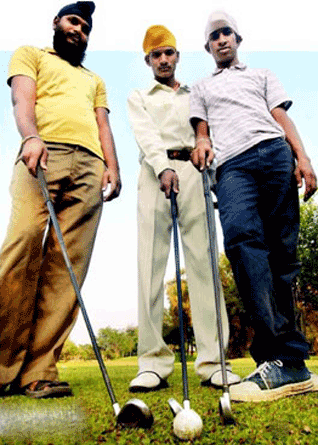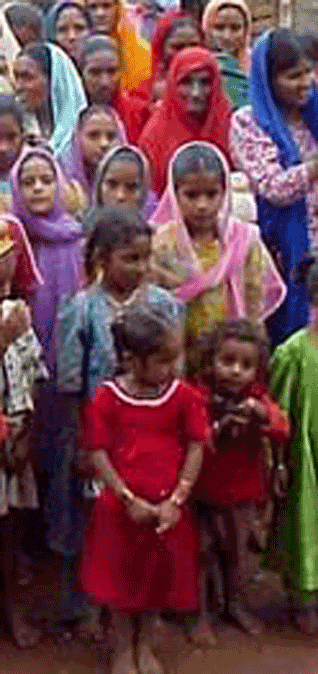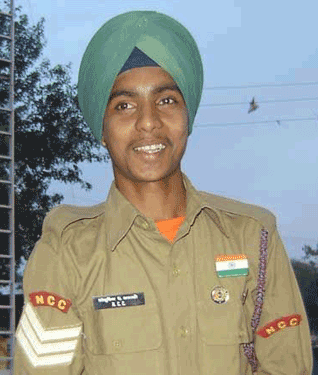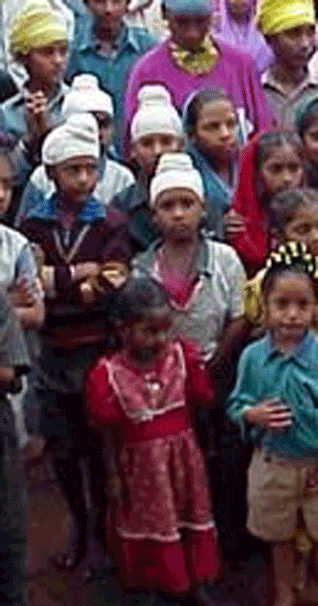
The Sikh spirit is alive and well! Above: Three young Sikligar Sikhs who began their lives eking out a living as caddies on a local golf course, are now hailed as champion golfers.



History
The Lost Tribes of The Sikhs
by BISWAJIT CHOUDHURY
South Indian Sikhs?
The description may seem unfamiliar. While Sikhs are overwhelmingly associated with Punjab, much less known are those from the community who made their home in Karnataka, Andhra Pradesh and Maharashtra centuries ago.
Known as Sikligar, there are, for instance, around 25 such families tucked away at the rear of a redeveloped slum in the peripheries of this city. Their present state, as that of other Sikh groups like Banjara, Lubana and Satnami, leading socio-economically marginalised lives and mostly outside Punjab, has prompted initiatives for the uplift of these "forgotten Sikhs".
The process of blending into southern India for the Sikligars began at the time of 10th Sikh Guru Gobind Singh, who came to the Deccan and passed away in 1708 at Nanded (Maharashtra).
"The resilience of these people in the face of centuries of vicissitudes and hardship is remarkable," says Harminder Singh, secretary of the Karnataka Sikh Welfare Society (KSWS).
Sikligars came to southern India as expert arms-making camp followers of the Tenth Guru. Sikligar is a compound of the Persian words 'saiqal' and 'gar' meaning a polisher of metal.
Famed for their weapon-making skills, the Sikligar continue with their traditional occupation to eke out a precarious living, crafting kitchen implements. To compound their current distress, they are mostly illiterate.
They are categorized as Scheduled Castes in the census of India.
The Bangalore-based KSWS provides scholarships to Sikligar children to acquire formal education. Older Sikligars are encouraged to join Punjabi learning classes to wean them away from illiteracy.
Amardas Singh, 23, is a Sikligar beneficiary of the KSWS scholarship programme with a job in the financial sector.
"Education will definitely help improve our condition," he says, "but with youngsters less inclined to the life of an iron smith, the craftsmanship coming down from our forefathers may be lost."
Amardas also points to the need to upgrade Sikligar skills, citing the case of the kirpan, the small sheathed dagger carried by observant Sikhs.
"The kirpan industry in India is quite hard hit by competition from cheaper kirpans made in China. If our artisans had the finance to upgrade their skills and equipment, we could compete better," Amardas says.
Another group of Sikhs came to the south early in the 19th century when the Nizam of Hyderabad raised a Sikh contingent in his army. The Sikhs stayed back and their descendants are known as the Dakhini or southern Sikhs.
There is a community of Ahom converts to Sikhism from the time of the Ninth Master, Guru Tegh Bahadar's travel to Assam. Agrahari Sikhs, also known as Bihari Sikhs, have lived for centuries in Bihar and Jharkhand.
Banjaras are a nomadic tribe who traditionally travelled with merchandise and are found across a large swathe of northern India, as well as in the south. Sikh Banjaras too travelled with armies of the past supplying them with provisions.
Sikhs comprise more than 60 percent of the population of Punjab.
But Sikh scholar Chiranjiv Singh speaks on the question of Sikhs born and bred amongst cultures distant from the Punjab region, the home of Sikhism. From a Punjabi Sikh family, Chiranjiv served as a senior Indian Administrative Service officer of the Karnataka cadre. Steeped in Kannada culture, he has made Bangalore his home.
Chiranjiv is of the view that non-Punjabi Sikhs and Sikh tribes, whose numbers together are said to be larger than Sikhs in the Punjab, "should be left free to chart their own future, independent of the lead of Punjabi Sikhs."
The relations of Sikhs of Punjab vis-a-vis other Sikhs is one complex part of this process, especially in the context of the depressed social and economic situation of the latter."They should be liberated, so to speak, from the hold of the Punjabi Sikhs," says Chiranjiv adding, "Sikhism, which was a movement ... for freedom from the inequities imposed by the social system, would thus be returning to its origins."
[Courtesy: IANS. Edited for sikhchic.com]
October 18, 2011
Conversation about this article
1: Harminder Dhillon (London, United Kingdom), October 18, 2011, 8:10 AM.
What an enlightening article! I loved reading it. It shows the legacy left behind by the work of our Gurus, and the resilience of these 'forgotten' Sikhs.
2: Harinder Singh (Pune, India), October 18, 2011, 9:08 AM.
A wonderful article. I salute all those that have taken this as a mission to help the lesser known, forgotten and underpriveleged Sikhs. This is akin to the Israelis who airlifted thousands of Jews from Ethiopia, out of a civil war and are now taking back a few thousand Jews who are living in Mizoram, India - one of the remotest places in India.
3: Gurwinder Singh (Hyderabad, India), October 18, 2011, 1:22 PM.
SOCH (Sikh Organization in Care of Humanity) has been helping children from Sikligar and Banjara background to get better education and health services. To know more about their ongoing seva - please visit www.sochnet.com
4: Kanwarjeet Singh (Franklin Park, New Jersey, U.S.A.), October 18, 2011, 1:44 PM.
So proud to see these Sikhs - they have maintained the Guru's bana even under extreme conditions of duress and they never tried to "fit in". Sikhs in the west and urban India, please pay heed! Thanks to organizations like Nishkam Seva who have been helping them out. So proud to see the picture of Sikh golfers above and the N.C.C. cadet - may they bathe in Guru's grace and keep their identity and spirit.
5: Kirpal Singh (DaytonaBeach, Florida, U.S.A.), October 18, 2011, 4:37 PM.
What a challenge to use our resources for the uplift of our own people! By the way, Sardar Nanak Singh Nishter of Hyderabad (Andhra Pradesh) is already active among these people. Our support for his activities will be very helpful to these Sikh brethren in South India.
6: Chintan Singh (San Jose, California, U.S.A.), October 18, 2011, 7:08 PM.
With all the money and resources available with the S.G.P.C., they are not able to provide these Sikhs (just Sikhs, not to be labeled as Sikligar or any other type) with small business loans, scholarships for higher education? It's truly sad.
7: Kirpal Singh (DaytonaBeach, Florida, U.S.A.), October 19, 2011, 11:46 AM.
About 10 years ago, I visited S. Joginder Singh Sandhu, 50 miles south of Nagpur, Maharashtra. He was doing pioneering work amongst the Banjara people. He passed away over a year ago. I wonder who is continuing his pioneer work over there now! Any info will be highly appreciated.
8: Harpreet Singh (Delhi, India), October 19, 2011, 4:07 PM.
Yes, the individuals and organizations mentioned above are doing great work for these Sikhs, as also are some more individuals and bodies. Two of them are S. Jagmohan Singh of Ludhiana (forgottensikhs.com; mybigideas@gmail.com) as well as S. Sukhdev Singh ji (guruangaddev.org) and many more. All of them hold regular meets as well and work in true harmony and Sikh spirit. May Waheguru bless all of them for doing this great service. As per my assessment, this constructive work is too big and needs full support and attention of the sangat. Maybe, we should stop or reduce other works like the unnecessary construction of gurdwara expansions or gilding them or spending too much on lavish langars and food stalls. The sangat must support these Sikhs so much that they can uplift these Sikhs as well as non-Sikhs of these areas as well.
9: Elizabeth Sholtys (Pune, India), October 26, 2011, 1:25 AM.
Anyone who is interested in helping the individuals specifically pictured/mentioned in this article should take a look at the Ashraya Initiative for Children (www.ashrayainitiative.org), working for the Sikligars in Yerwada, Pune. All of the young men in the top picture are in our programs (see, for example, a blog entry about Mayur, the boy in the middle, who just graduated from 10th standard and started college through AIC: http://ashrayainitiative.blogspot.com/2011/07/going-pro.html). If you are interested in these "forgotten Sikhs", please check out the work that we do with this uniquely marginalized community!
10: Jaskaran Singh (Amritsar, Punjab), September 19, 2013, 1:58 PM.
What is the population of Sikligar, Satnami and Vanjara Sikhs in India?
11: Aman (India), September 17, 2014, 4:52 AM.
I have heard that they are more than 80 million all over India. But our rich gurdwara committees did not pay any heed to these 'tribal' Sikhs. They are neglected as they have no "votes" and houses. And living in extreme poverty. We must help them so that they too can live a dignified life.


